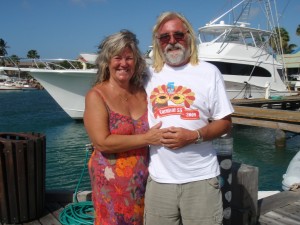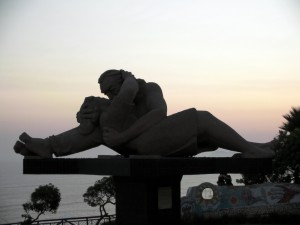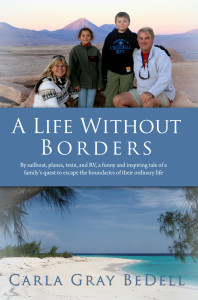We returned late Saturday from our one month adventure to South America, namely Peru and Chile. We had an amazing time. Coming back to the heat, after having great fall weather is hard. I for one have not gotten use to the heat yet and am very tired. I’m finally able to update the website for our trip. Peru and Chile had good inter net, but we forgot the device that allowed us to upload the pictures and I had to wait until we returned. So, sit back, take some time and I will take you through an incredible journey.
It started about mid April. It was around Easter time, and we were still enjoying Aruba, but started to look for a weather window to leave. Walking down the dock one day, we passed a guy working on his anchor. I asked if he was headed to Colombia and he said no, he and his wife had just returned from Chile and Argentina. They had been gone a month and left the boat here. That stopped me short. You could do that from here? Dan and I had talked about doing a land tour from Colombia, but we had never thought about leaving from Aruba instead. His name was Mike, from the UK and a few minutes later his wife Ineke (Australian) joined the conversation. They had a great time. The year before they had left the boat in Curacao and toured Peru and Chile. Their trip had started when they were hauled out in Curacao and Ineke asked Mike “You want to go somewhere?” and off they went. I was dumbfounded. That never even occurred to me. We met with them again another night over sundowners and they showed us their pictures and told us of their adventures. They had no plans when they left, they travelled on buses and went when and where they wanted to. Their enthusiasm was so contagious. Could we really do that? Later, when Dan and I were seriously discussing it, he asked me why I wanted to do this. I replied “Because I want to be like Ineke. Did you see her face light up when she talked about their trip? How she just said one day why don’t we go somewhere? I want to live my life like that, really living, not being afraid to say yes. I want to be her.”
So in a very short time we had decided on Peru and Chile (originally Peru and Bolivia but it would cost over $500.00 for a visa into Bolivia), borrowed the Chile guidebook from Mike and Ineke, got our own Lonely Planet guide for Peru, and went shopping for socks. Our preparation for the trip was a departure from how we would normally prepare to go somewhere. The old us would have had to have a plan, knew exactly where and how we were going every step of the way and would have bought all new stuff to take with us. Instead, we made flight reservations to fly into Lima Peru, and arbitrarily picked flying back from Santiago Chile a month later. The only other plan we made was to have a hotel waiting that first night as we would arrive at 1:30am.
Once we made it official, we had less than a week to prepare. The Marina agreed to watch our boat for us, come in everyday, air her out and check the systems. No charge. We love the Marina! For packing, we would only take 1 backpack apiece, and 2 very small rolling suitcases (small enough so that if we were stranded somewhere, we could easily carry them). While I started preparing the boat to be left for a month, Dan and Tristan went shopping for “comfort items”. What they bought:
2 cheap (but nice) 24 inch rolling suitcases Wet Wipes earplugs (Mike’s suggestion as the movies on the bus can get really loud) blow up neck rolls for everyone (really came in handy sleeping on the bus) 2 sleeping bags for us (Again suggested by Mike and as the bus can get very cold. Tristan and Tessa used their polar fleece blankets from the boat) Band Aids Toilet Seat Covers (nice idea but outside of the hotel, most toilets in Peru didn’t have seats) Snacks Peanut Butter/Jelly Journals (everyone had one) Lots and lots of Ziplocs in all sizes Lonely Planet Peru guide socks Tennis shoes for Tessa A heavy jacket for Dan A heavy jacket for me Rain Ponchos (We had no idea what the weather would be like, only that we should miss the rainy season but were headed into their fall) New backpack for Tristan 2 small cheap daypacks garbage bags
Everyone understood that it was important how/what they packed as they had to carry it. Our backpacks were filled with A blanket/sleeping bag wet wipes/antibacterial wipes, toilet paper, a towel books to read journal electronics (such as IPODs or Tristan brought his PSP and Tessa her Nintendo DS) camera (I carried the underwater camera and the underwater video camera and Dan carried his Canon) Snacks (I carried the peanut butter/jelly combo) A total change of clothes inside a ziplock bag earplugs neckpillow aspirins/band aids (the usual) Tristan put himself solely in charge of the guidebook The Spanish phrase book and a Spanish dictionary a few garbage bags A bottle of water
The two rolling suitcases held the rest of our clothes, basically 4 underwear apiece, 1 or 2 pair of pants (Tristan and Dan had the zip off pants that turn into shorts. That worked really well) 1 pair of shorts each 4 pairs of sock each 1 pair of flip flops each 2 short sleeve shirts and 2 to 3 long sleeve shirts each
After a brief set back of the toilet being plugged and Dan having to run a new toilet hose to the outside of the boat (one part involved all of us pulling on a hose full of you know what!) we were ready to go.
We had a short layover in Bogota Colombia, then landed in Lima Peru about 1:30 am. After the initial excitement of actually being in Peru (I couldn’t stop saying “We’re in Peru! We’re in Peru!”) the first thing we noticed was the quietness. Sure it was early in the morning, but even at the baggage claim, everyone was really quiet, the airport was quiet. After getting our bags, and locating the driver the Hotel was nice enough to have waiting for us as a free service, we headed into the foggy night.
Hotel San Antonio Abad was actually in Mira Flores, a short drive outside of Lima. It was an older Hotel, built more in the style of a huge house, with a wide mahogany staircase winding up to our room on the third floor. Our accomodations were the first of what would become typical of our trip, a triple which means 1 double and 2 single beds, and breakfast. The room was too warm at first, luckily by morning the air conditioner had kicked in. This was a surprise as we were expecting it to be colder.
Breakfast that morning was again typical of what we would later see. Traditional Peruvian breakfasts consist of bread and jelly, maybe some fruit or fruit juice and coffee. Luckily this Hotel also included eggs. Breakfast is our kids favorite meal and this was going to be a problem going forward. After our late meal, Jose our cabdriver from last night agreed to give us a tour of the city for $10.00 US total. That was a no brainer. Even though the city is on the Pacific Coast, air pollution is bad, due to the over 8.2 million people who live there and the heavy traffic. Driving in Lima reminded us very much of driving in Santiago, Dominican Republic. Cars drove everywhere, in oncoming lanes, not paying attention to traffic lights, people in the middle of the road trying to sell things. We knew we were going to like it here!! But in the midst of all this chaos, traffic and people, the one thing we noticed was the QUIET. No loud horn honking, no music blasting, no one even talking loud, just quiet. It was weird. And it was hot. Unexpectedly so. We were 12 degrees below the equator, this was their fall, but it was warm.
Jose took us to the center of the city, to the Plaza de Armas. Every Latin Country has a Plaza de Armas, sometimes more than one, and that’s where you want to be. It’s generally in the center of the city, and is a huge open square, with park benches, lovely trees, sometimes fountains. It’s an oasis of beauty and peace in a bustling city. At noon we sweated in the hot sun watching the changing of the guard at the Palacio de Gobieno, the residence of the Peruvian President. Afterwards we walked past a few of the cathedrals and eventually took a tour at the Monasterio de San Francisco. Unfortunately, as in nearly every museum or church we toured, we couldn’t take pictures. We were never quiet sure what they were trying to protect. Perhaps the unseemly excesses of the Church?
The draw at the Monasterio, in addition to the museum of religious art, and the library of antique books dating back to the 1500’s, was the catacombs. Buried beneath the monastery are the bones of over 70,000 bodies, organized by bone types. For example there was an open crypt of skulls, an open crypt of leg bones and so on. The catacombs were narrow and winding and in some places a little dark, not to mention the musty underground smell. It’s definitely not the place for anyone who was claustrophobic. And who was buried here? The rich and famous. The idea was that the closer the burial to the church, the closer to Heaven. And how did you get this prime real estate? Money. Lots of it to the Catholic Church. More on that later.
Alex, our guide was very nice and spoke good English. He filled us in on some history of Peru and their not so friendly relation with Chile. He had the look of what we came to know as the more indigenous Peruvian, perhaps a lineage to the Incas, darker skin, and amazing hair. In fact, that was one of the first things we noticed about the Peruvian people. They have thick beautiful hair, and both the men and women are equally proud of it. The women keep theirs in long braids, while the men all have fashionable haircuts. In our study on the Incas, we learned they really loved their hair and in fact each Inca ruler had his own unique hairstyle, a tradition carried forward over 500 years. We also learned there had been a backlash against the darker skin Peruvians generally considered peasants, by the whiter, fair skinned mestizos (people of mixed indigenous and Spanish descent) who tend to be wealthier and hold higher positions in society. All I can tell you is that the people of Peru are very good looking. The indigenous women, even the ones high in the mountains, with no makeup, carrying a baby, lugging around a huge pack of things to sell, are BEAUTIFUL. Perfect teeth, perfect complexions, perfect hair. They are obviously living right. One Peruvian told said it is because of the Coca Leaf that most people chew for altitude sickness. While banned in the United States, it is filled with vitamins and minerals, such as calcium and is good for altitude sickness. It seems to be good for the teeth as the Peruvian people, male and female, have the most beautiful, genuine smile we have ever seen.
After the museum, we headed over to a travel agency to see about a bus to our next stop, Nazca. The agent was very helpful and we were able to get tickets on a bus leaving at 7 am the next morning. The plan was to leave at 7 am, arrive in Nazca around 3 pm, fly over the Nazca lines. Instead of spending the night in Nazca, we would board an overnight bus leaving Nazca around ten pm and arriving around six thirty am in Arequipa. The bus we would be taking was a double decker bus. The fully reclining seats in the VIP section were full for both trips, so we would be on the upper level with seats reclining to what they referred to as the “Semi Cama” or semi bed position. The Lonely Planet guide had horror stories of bus jackings, robberies and kidnappings on the Nazca to Arequipa overnight leg, (which of course Tristan had read about) so I was very nervous, but the ticket agent assured me those things were in the past, and this bus did not make any stops, so I felt better. Besides, Ineke and Mike had gone the same way and they had been fine, and this was one of the top of the line busses. On the way back to the hotel we had Jose drop us off at the boardwalk in Mira Flores. We ate dinner on a cliff overlooking the Pacific Ocean, watching the surfers. Dan says the coast here is very typical of a California coast, with high cliffs overlooking the beach. It was very beautiful but we’ve seen enough beaches for awhile. After a great meal topped off by our first Pisco Sour, we headed back to the hotel for an early night.
 Mike and Ineke
Mike and Ineke
 Lover’s Park Mira Flores
Lover’s Park Mira Flores
The exchange rate at the time was around 3.05 Peruvian Nuevo Sols to $1.00 US dollar. Our 4 tickets from Lima to Nazca cost us around $88.00 US total and the 4 tickets on the overnight bus from Nazca to Arequipa cost $107.00 US total.


1 Trackbacks and Pingbacks
[…] See more here: Peru and Chile Part 1 Lima Peru | Alegria […]
Write a Comment
You must be logged in to post a comment.